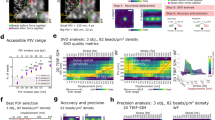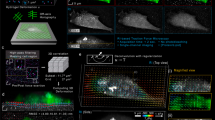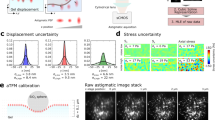Abstract
Cells continuously exert or respond to mechanical force. Measurement of these nanoscale forces is a major challenge in cell biology; yet such measurement is essential to the understanding of cell regulation and function. Current methods for examining mechanical force generation either necessitate dedicated equipment or limit themselves to coarse-grained force measurements on the micron scale. In this protocol, we describe stimulated emission depletion traction force microscopy—STED-TFM (STFM), which allows higher sampling of the forces generated by the cell than conventional TFM, leading to a twofold increase in spatial resolution (of up to 500 nm). The procedure involves the preparation of functionalized polyacrylamide gels loaded with fluorescent beads, as well as the acquisition of STED images and their analysis. We illustrate the approach using the example of HeLa cells expressing paxillin-EGFP to visualize focal adhesions. Our protocol uses widely available laser-scanning confocal microscopes equipped with a conventional STED laser, open-source software and common molecular biology techniques. The entire STFM experiment preparation, data acquisition and analysis require 2–3 d and could be completed by someone with minimal experience in molecular biology or biophysics.
This is a preview of subscription content, access via your institution
Access options
Access Nature and 54 other Nature Portfolio journals
Get Nature+, our best-value online-access subscription
$29.99 / 30 days
cancel any time
Subscribe to this journal
Receive 12 print issues and online access
$259.00 per year
only $21.58 per issue
Buy this article
- Purchase on Springer Link
- Instant access to full article PDF
Prices may be subject to local taxes which are calculated during checkout





Similar content being viewed by others
References
Moeendarbary, E. & Harris, A.R. Cell mechanics: principles, practices, and prospects. Wiley Interdiscip. Rev. Syst. Biol. Med. 6, 371–388 (2014).
Capitanio, M. & Pavone, F.S. Interrogating biology with force: single molecule high-resolution measurements with optical tweezers. Biophys. J. 105, 1293–1303 (2013).
Bao, G. & Suresh, S. Cell and molecular mechanics of biological materials. Nat. Mater. 2, 715–725 (2003).
Janmey, P.A. & Miller, R.T. Mechanisms of mechanical signaling in development and disease. J. Cell Sci. 124, 9–18 (2011).
Valero, C., Javierre, E., García-Aznar, J.M. & Gómez-Benito, M.J. A cell-regulatory mechanism involving feedback between contraction and tissue formation guides wound healing progression. PLoS One 9, e92774 (2014).
Sasaki, N. in Viscoelasticity - From Theory to Biological Applications 99–122 (InTech, 2012). http://dx.doi.org/10.5772/49979.
Moeendarbary, E. et al. The cytoplasm of living cells behaves as a poroelastic material. Nat. Mater. 12, 253–261 (2013).
Fritzsche, M., Erlenkämper, C., Moeendarbary, E., Charras, G. & Kruse, K. Actin kinetics shapes cortical network structure and mechanics. Sci. Adv. 2, 1–13 (2016).
Geiger, B., Spatz, J.P. & Bershadsky, A.D. Environmental sensing through focal adhesions. Nat. Rev. Mol. Cell Biol. 10, 21–33 (2009).
Sabass, B., Gardel, M.L., Waterman, C.M. & Schwarz, U.S. High resolution traction force microscopy based on experimental and computational advances. Biophys. J. 94, 207–220 (2008).
Colin-York, H. et al. Super-resolved traction force microscopy (STFM). Nano Lett. 16, 2633–2638 (2016).
Wilson, K. et al. Mechanisms of leading edge protrusion in interstitial migration. Nat. Commun. 4, 2896 (2013).
Dembo, M. & Wang, Y.-L. Stresses at the cell-to-substrate interface during locomotion of fibroblasts. Biophys. J. 76, 2307–2316 (1999).
Butler, J.P., Tolić-Nørrelykke, I.M., Fabry, B. & Fredberg, J.J. Traction fields, moments, and strain energy that cells exert on their surroundings. Am. J. Physiol. Cell Physiol. 282, C595–C605 (2002).
Judokusumo, E., Tabdanov, E., Kumari, S., Dustin, M.L. & Kam, L.C. Mechanosensing in T lymphocyte activation. Biophys. J. 102, L5–L7 (2012).
Fischer, R.S., Myers, K.A., Gardel, M.L. & Waterman, C.M. Stiffness-controlled three-dimensional extracellular matrices for high-resolution imaging of cell behavior. Nat. Protoc. 7, 2056–2066 (2012).
Damljanovic, V., Lagerholm, B.C. & Jacobson, K. Bulk and micropatterned conjugation of extracellular matrix proteins to characterized polyacrylamide substrates for cell mechanotransduction assays. Biotechniques 39, 847–851 (2005).
Gould, H.J. & Sutton, B.J. IgE in allergy and asthma today. Nat. Rev. Immunol. 8, 205–217 (2008).
Fritzsche, M. & Charras, G. Dissecting protein reaction dynamics in living cells by fluorescence recovery after photobleaching. Nat. Protoc. 10, 660–680 (2015).
Danuser, G., Allard, J. & Mogilner, A. Mathematical modeling of eukaryotic cell migration: insights beyond experiments. Annu. Rev. Cell Dev. Biol. 29, 501–528 (2013).
Lewalle, A. et al. A phenomenological density-scaling approach to lamellipodial actin dynamics. Interface Focus 4, 20140006 (2014).
Stachowiak, M.R. et al. Mechanism of cytokinetic contractile ring constriction in fission yeast. Dev. Cell 29, 547–561 (2014).
Pollard, T.D. Mechanics of cytokinesis in eukaryotes. Curr. Opin. Cell Biol. 22, 50–56 (2010).
Coward, J., Germain, R.N. & Altan-Bonnet, G. Perspectives for computer modeling in the study of T cell activation. Cold Spring Harb. Perspect. Biol. 2, a005538 (2010).
Worth, A.J.J. et al. Disease-associated missense mutations in the EVH1 domain disrupt intrinsic WASp function causing dysregulated actin dynamics and impaired dendritic cell migration. Blood 121, 72–84 (2013).
Stout, D.A. et al. Mean deformation metrics for quantifying 3D cell–matrix interactions without requiring information about matrix material properties. Proc. Natl. Acad. Sci. USA 113, 2898–2903 (2016).
Polacheck, W.J. & Chen, C.S. Measuring cell-generated forces: a guide to the available tools. Nat. Methods 13, 415–423 (2016).
del Álamo, J.C. et al. Three-dimensional quantification of cellular traction forces and mechanosensing of thin substrata by Fourier traction force microscopy. PLoS One http://dx.doi.org/10.1371/journal.pone.0069850 (2013).
Thomas, D.G. et al. Non-muscle myosin IIB is critical for nuclear translocation during 3D invasion. J. Cell Biol. 210, 583–594 (2015).
Hell, S.W. & Wichmann, J. Breaking the diffraction resolution limit by stimulated emission: stimulated-emission-depletion fluorescence microscopy. Opt. Lett. 19, 780–782 (1994).
Gould, T.J., Kromann, E.B., Burke, D., Booth, M.J. & Bewersdorf, J. Auto-aligning stimulated emission depletion microscope using adaptive optics. Opt. Lett. 38, 1860–1862 (2013).
Grashoff, C. et al. Measuring mechanical tension across vinculin reveals regulation of focal adhesion dynamics. Nature 466, 263–266 (2010).
Ghassemi, S. et al. Cells test substrate rigidity by local contractions on submicrometer pillars. Proc. Natl. Acad. Sci. USA 109, 5328–5333 (2012).
Vogel, V. & Sheetz, M. Local force and geometry sensing regulate cell functions. Nat. Rev. Mol. Cell Biol. 7, 265–275 (2006).
Blakely, B.L. et al. A DNA-based molecular probe for optically reporting cellular traction forces. Nat. Methods 11, 1229–1232 (2014).
Stabley, D.R., Jurchenko, C., Marshall, S.S. & Salaita, K.S. Visualizing mechanical tension across membrane receptors with a fluorescent sensor. Nat. Methods 9, 64–67 (2012).
Liu, Y., Yehl, K., Narui, Y. & Salaita, K. Tension sensing nanoparticles for mechano-imaging at the living/nonliving interface. J. Am. Chem. Soc. 135, 5320–5323 (2013).
Wang, X. & Ha, T. Defining single molecular forces required to activate integrin and notch signaling. Science 340, 991–994 (2013).
Morimatsu, M., Mekhdjian, A.H., Chang, A.C., Tan, S.J. & Dunn, A.R. Visualizing the interior architecture of focal adhesions with high-resolution traction. Nano Lett. 15, 2220–2228 (2015).
Müller, D.J. & Dufrêne, Y.F. Atomic force microscopy as a multifunctional molecular toolbox in nanobiotechnology. Nat. Nanotechnol. 3, 261–269 (2008).
Harris, A.R. & Charras, G.T. Experimental validation of atomic force microscopy-based cell elasticity measurements. Nanotechnology 22, 345102 (2011).
Hu, K.H. & Butte, M.J. T cell activation requires force generation. J. Cell Biol. 213, 535–542 (2016).
Whited, A.M. & Park, P.S.-H. Atomic force microscopy: a multifaceted tool to study membrane proteins and their interactions with ligands. Biochim. Biophys. Acta. 1838, 56–68 (2014).
Alcaraz, J. et al. Microrheology of human lung epithelial cells measured by atomic force microscopy. Biophys. J. 84, 2071–2079 (2003).
Darling, E.M., Topel, M., Zauscher, S., Vail, T.P. & Guilak, F. Viscoelastic properties of human mesenchymally-derived stem cells and primary osteoblasts, chondrocytes, and adipocytes. J. Biomech. 41, 454–464 (2008).
Moreno-Flores, S., Benitez, R., Vivanco, M.d. & Toca-Herrera, J.L. Stress relaxation and creep on living cells with the atomic force microscope: a means to calculate elastic moduli and viscosities of cell components. Nanotechnology 21, 445101 (2010).
Guck, J. et al. Optical deformability as an inherent cell marker for testing malignant transformation and metastatic competence. Biophys. J. 88, 3689–3698 (2005).
Guck, J. et al. The optical stretcher: a novel laser tool to micromanipulate cells. Biophys. J. 81, 767–784 (2001).
Hochmuth, F.M., Shao, J.Y., Dai, J. & Sheetz, M.P. Deformation and flow of membrane into tethers extracted from neuronal growth cones. Biophys. J. 70, 358–369 (1996).
Raucher, D. & Sheetz, M.P. Characteristics of a membrane reservoir buffering membrane tension. Biophys. J. 77, 1992–2002 (1999).
Pontes, B. et al. Membrane elastic properties and cell function. PLoS One 8, e67708 (2013).
Hochmuth, R.M. Micropipette aspiration of living cells. J. Biomech. 33, 15–22 (2000).
Tseng, Y., Kole, T.P. & Wirtz, D. Micromechanical mapping of live cells by multiple-particle-tracking microrheology. Biophys. J. 83, 3162–3176 (2002).
Scarcelli, G. et al. Noncontact three-dimensional mapping of intracellular hydromechanical properties by Brillouin microscopy. Nat. Methods 12, 1132–1134 (2015).
Discher, D.E., Janmey, P. & Wang, Y.-L. Tissue cells feel and respond to the stiffness of their substrate. Science 310, 1139–1143 (2005).
Tse, J.R., Engler, A.J., Tse, J.R. & Engler, A.J. Preparation of hydrogel substrates with tunable mechanical properties. Curr. Protoc. Cell Biol. Chapter 10, Unit 10.16 (2010).
Wen, J.H. et al. Interplay of matrix stiffness and protein tethering in stem cell differentiation. Nat. Mater. 13, 979–987 (2014).
Knoll, S.G., Ali, M.Y. & Saif, M.T. A novel method for localizing reporter fluorescent beads near the cell culture surface for traction force microscopy. J. Vis. Exp. (91), 51873 (2014).
Clausen, M.P. et al. Pathways to optical STED microscopy. NanoBioImaging 1, 1–12 (2013).
Vicidomini, G. et al. Sharper low-power STED nanoscopy by time gating. Nat. Methods 8, 571–573 (2011).
Martiel, J.L. et al. Measurement of cell traction forces with ImageJ. Methods Cell Biol. 125, 269–287 (2015).
Schwarz, U.S. & Soiné, J.R.D. Traction force microscopy on soft elastic substrates: a guide to recent computational advances. Biochim. Biophys. Acta. 1853, 3095–3104 (2015).
Han, S.J., Oak, Y., Groisman, A. & Danuser, G. Traction microscopy to identify force modulation in subresolution adhesions. Nat. Methods 12, 653–656 (2015).
Schwarz, U.S. et al. Calculation of forces at focal adhesions from elastic substrate data: the effect of localized force and the need for regularization. Biophys. J. 83, 1380–1394 (2002).
Acknowledgements
We gratefully acknowledge support from the Wolfson Imaging Centre (C. Lagerholm and E. Garcia) and funding from the Medical Research Council (MRC; grant no. MC_UU_12010/unit programme G0902418 and grant no. MC_UU_12025), the MRC/Biotechnology and Biological Sciences Research Council (BBSRC)/Engineering and Physical Sciences Research Council (EPSRC; grant no. MR/K01577X/1), the Wellcome Trust (grant ref. 104924/14/Z/14) and the Wolfson Foundation. We thank E. Sezgin for kindly reading the manuscript.
Author information
Authors and Affiliations
Contributions
H.C.-Y. conducted the experiments. H.C.-Y., M.F. and C.E. wrote the manuscript.
Corresponding author
Ethics declarations
Competing interests
The authors declare no competing financial interests.
Rights and permissions
About this article
Cite this article
Colin-York, H., Eggeling, C. & Fritzsche, M. Dissection of mechanical force in living cells by super-resolved traction force microscopy. Nat Protoc 12, 783–796 (2017). https://doi.org/10.1038/nprot.2017.009
Published:
Issue Date:
DOI: https://doi.org/10.1038/nprot.2017.009
This article is cited by
-
Trends in mechanobiology guided tissue engineering and tools to study cell-substrate interactions: a brief review
Biomaterials Research (2023)
-
Hydrogel-based molecular tension fluorescence microscopy for investigating receptor-mediated rigidity sensing
Nature Methods (2023)
-
Stiff matrices enhance myoblast proliferation, reduce differentiation, and alter the response to fluid shear stress in vitro
Cell Biochemistry and Biophysics (2022)
-
Two-dimensional TIRF-SIM–traction force microscopy (2D TIRF-SIM-TFM)
Nature Communications (2021)
-
Astigmatic traction force microscopy (aTFM)
Nature Communications (2021)
Comments
By submitting a comment you agree to abide by our Terms and Community Guidelines. If you find something abusive or that does not comply with our terms or guidelines please flag it as inappropriate.



